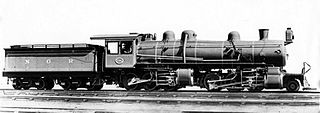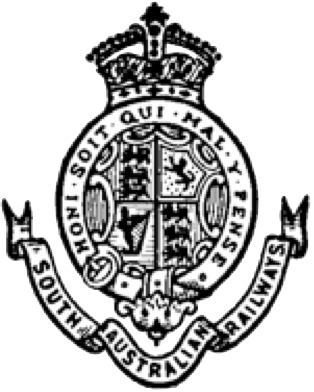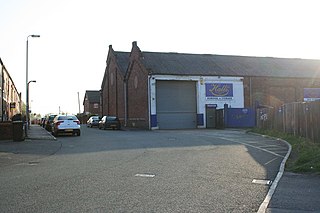
A narrow-gauge railway is a railway with a track gauge narrower than 1,435 mmstandard gauge. Most narrow-gauge railways are between 600 mm and 1,067 mm.

A Mallet locomotive is a type of compound articulated steam locomotive, invented by the Swiss engineer Anatole Mallet (1837–1919).

0-6-0 is the Whyte notation designation for steam locomotives with a wheel arrangement of no leading wheels, six powered and coupled driving wheels on three axles, and no trailing wheels. Historically, this was the most common wheel arrangement used on both tender and tank locomotives in versions with both inside and outside cylinders.

A Garratt locomotive is a type of articulated steam locomotive invented by British engineer Herbert William Garratt that is articulated into three parts. Its boiler, firebox, and cab are mounted on a centre frame or "bridge". The two other parts, one at each end, have a pivot to support the central frame; they consist of a steam engine unit – with driving wheels, trailing wheels, valve gear, and cylinders, and above it, fuel and/or water storage.

4-4-0, in the Whyte notation, denotes a steam locomotive with a wheel arrangement of four leading wheels on two axles, four powered and coupled driving wheels on two axles, and no trailing wheels.

Under the Whyte notation for the classification of steam locomotives, 0-4-2 represents the wheel arrangement with no leading wheels, four powered and coupled driving wheels on two axles and two trailing wheels on one axle. While the first locomotives of this wheel arrangement were tender engines, the configuration was later often used for tank engines, which is noted by adding letter suffixes to the configuration, such as 0-4-2T for a conventional side-tank locomotive, 0-4-2ST for a saddle-tank locomotive, 0-4-2WT for a well-tank locomotive and 0-4-2RT for a rack-equipped tank locomotive.

Under the Whyte notation for the classification of steam locomotives by wheel arrangement, 2-6-6-0 is a locomotive with one pair of unpowered leading wheels, followed by two sets of three pairs of powered driving wheels and no trailing wheels. The wheel arrangement was principally used on Mallet-type articulated locomotives. Some tank locomotive examples were also built, for which various suffixes to indicate the type of tank would be added to the wheel arrangement, for example 2-6-6-0T for an engine with side-tanks.

In Whyte notation for the classification of steam locomotives by wheel arrangement, an 0-4-4-2 is a locomotive that has no leading wheels, two sets of four driving wheels and two trailing wheels.

George England and Co. was an early English manufacturer of steam locomotives founded by the engineer George England of Newcastle upon Tyne (1811–1878). The company operated from the Hatcham Iron Works in New Cross, Surrey, and began building locomotives in 1848.

South Australian Railways (SAR) was the statutory corporation through which the Government of South Australia built and operated railways in South Australia from 1854 until March 1978, when its non-urban railways were incorporated into Australian National, and its Adelaide urban lines were transferred to the State Transport Authority.

The Castlederg and Victoria Bridge Tramway was a 3 ft narrow gauge railway operating in County Tyrone, Northern Ireland. It opened in 1883 and closed in 1933.

The Cork and Muskerry Light Railway was a 3 ft narrow gauge railway in County Cork, Ireland. The first part of the railway opened in 1887 and closed in 1934. A major reason for building the railway was to exploit tourist traffic to Blarney Castle.

Under the Whyte notation for the classification of steam locomotives by wheel arrangement, 2-6-2+2-6-2 is an articulated locomotive using a pair of 2-6-2 power units back to back, with the boiler and cab suspended between them. The 2-6-2 wheel arrangement has a single pair of leading wheels in a leading truck, followed by three coupled pairs of driving wheels and a pair of trailing wheels in a trailing truck.

The Ambarawa Railway Museum is a museum located in Ambarawa in Central Java, Indonesia. The museum preserves around 21 steam locomotives and focuses on tourism train tours hauled by 3 operational steam engines and a hydraulic diesel engine, using the remains of the closing of the 3 ft 6 in (1,067 mm) railway line.

Wigan Corporation Tramways operated a tramway service in Wigan, England, between 1901 and 1931. The first tramway service in the town was run by the Wigan Tramways Company, whose horse trams began carrying passengers in 1880. They began replacing horses with steam tram locomotives from 1882, but the company failed in 1890 when a Receiver was appointed to manage it. The Wigan & District Tramways Company took over the system in 1893 and ran it until 1902. Meanwhile, Wigan Corporation were planning their own tramway system, obtaining an authorising Act of Parliament in 1893, and a second one in 1898. This enabled them to build electric tramways, and in 1902, they took over the lines of the Wigan & District Tramways Company.
At the peak of Britain’s first-generation tramways, it was possible to travel by tram all the way from Pier Head at Liverpool to the Pennines in Rochdale by tram.

The Cape Town Railway & Dock 0-4-2 of 1860 was a South African steam locomotive from the pre-Union era in the Cape of Good Hope.

The Cape Town Railway & Dock 2-4-0T of 1864 was a South African steam locomotive from the pre-Union era in the Cape of Good Hope.

Rheidol, formerly named Treze de Maio and Talybont, was a 2-4-0T steam locomotive built by W.G. Bagnall in Staffordshire, England, in 1896. Originally built to a gauge of 2 ft 5+1⁄2 in, it was for a Brazilian sugar plantation, however the order was cancelled before it was exported. The locomotive was then regauged and renamed for the 2 ft 3 in -gauge Plynlimon and Hafan Tramway, in Wales, where it worked from August 1897 until 1899. It was then regauged and renamed a second time for 1 ft 11+3⁄4 in -gauge Vale of Rheidol Railway, in 1900. It worked on the Vale of Rheidol until 1924, when it was scrapped.

Gibbons & Harris were manufacturers of narrow gauge geared steam locomotives between 1905 and 1912 in Auckland, New Zealand.

The Gouvernment of Atjeh and Dependencies was an administrative subdivision (governorate) of the Dutch East Indies located in northern Sumatra in the region of present-day Aceh, Indonesia which existed from the late nineteenth century to 1938. The capital of the governorate was at Koetaradja. In 1938, due to a reorganization of the government structure of the Indies, it no longer had a governor and became a Residency instead, called the Atjeh and Dependencies Residency.




















